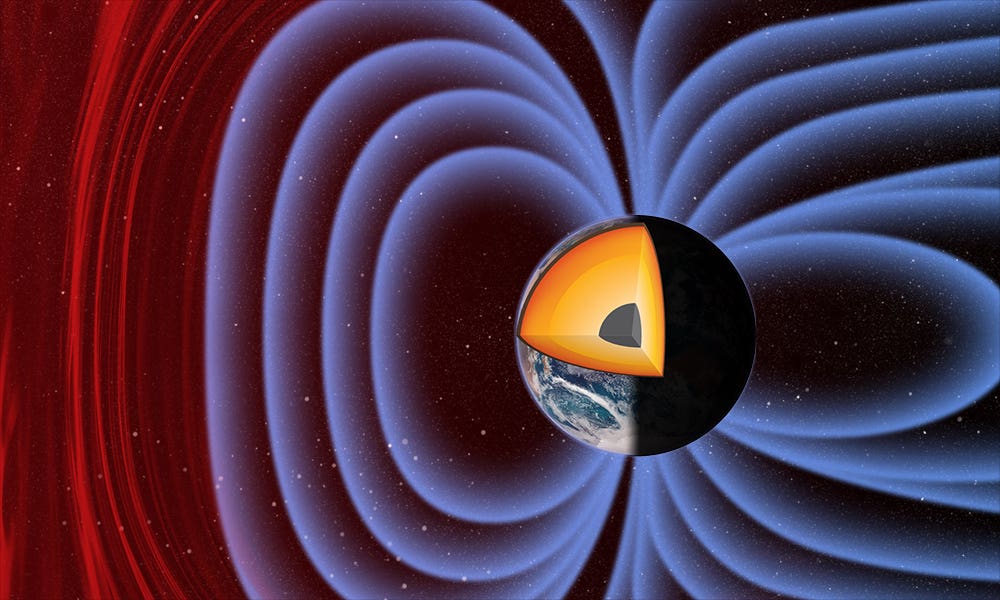Mysterious doughnut-shaped region inside Earth’s core linked to planet’s magnetic field
This doughnut-shaped region, located thousands of kilometers below the surface, has eluded detection until now.

The Earth’s core consists of two layers: a solid inner core and a liquid outer core. (CREDIT: CC BY-SA 3.0)
Deep within Earth, in the liquid outer core, scientists from The Australian National University (ANU) have uncovered a fascinating new structure that may shed light on the planet's magnetic field. This doughnut-shaped region, located thousands of kilometers below the surface, has eluded detection until now, offering fresh insights into Earth's inner dynamics.
The Earth's core consists of two layers: a solid inner core and a liquid outer core, both enveloped by the mantle. The newly discovered structure lies at the top of the liquid outer core, where it meets the mantle, and is found only at low latitudes, aligned parallel to the equator. According to ANU seismologists, this peculiar region, with its distinctive doughnut shape, has slower seismic waves than the rest of the outer core.
Professor Hrvoje Tkalčić, an ANU geophysicist and co-author of the study, describes the region as confined to low latitudes and having a thickness that reaches several hundred kilometers beneath the core-mantle boundary. "The region sits parallel to the equatorial plane, is confined to the low latitudes, and has a doughnut shape," he explains. The slower seismic waves detected in this region are a key feature of the discovery.
The method used to uncover this hidden structure was innovative. Instead of relying on traditional seismic wave observation techniques, which typically focus on signals generated by earthquakes within the first hour, the ANU team analyzed waveforms many hours after the earthquakes occurred.
This approach allowed them to observe the seismic waves as they reverberated through Earth's outer core over extended periods, leading to the discovery of the low-velocity region.
Related Stories
"By understanding the geometry of the paths of the waves and how they traverse the outer core’s volume, we reconstructed their travel times through the Earth, demonstrating that the newly discovered region has low seismic speeds," Professor Tkalčić explains. This novel approach provided much better volumetric coverage of the outer core, revealing the structure that had remained hidden in previous studies.
Dr. Xiaolong Ma, another co-author of the study, emphasizes the importance of this discovery in understanding Earth's magnetic field. The outer core, composed mainly of liquid iron and nickel, is responsible for generating the magnetic field that surrounds Earth. This magnetic shield protects the planet from harmful solar winds and radiation, making life possible on the surface.
"There are still mysteries about the Earth's outer core that are yet to be solved, which requires multidisciplinary efforts from seismology, mineral physics, geomagnetism, and geodynamics," Dr. Ma notes. Understanding the composition of the outer core, including the presence of light chemical elements, is crucial for unraveling the dynamics of the magnetic field.
The low seismic velocity observed in the newly discovered region suggests a high concentration of light chemical elements, which would cause the waves to slow down. These elements, combined with temperature differences, are believed to play a role in stirring the liquid in the outer core, contributing to the generation of Earth's magnetic field.
"Our findings are interesting because this low velocity within the liquid core implies that we have a high concentration of light chemical elements in these regions that would cause the seismic waves to slow down," Professor Tkalčić explains. This discovery not only enhances our understanding of Earth's magnetic field but also has implications for studying the magnetic fields of other planets.
The magnetic field is a fundamental component of life on Earth, and any changes in its strength or stability could have significant consequences. By gaining a deeper understanding of the outer core's composition and dynamics, scientists hope to predict how the magnetic field might evolve in the future.
This research could potentially help forecast when the magnetic field might weaken or cease altogether, providing critical information for safeguarding life on Earth.
"The magnetic field is a fundamental ingredient that we need for life to be sustained on the surface of our planet," Professor Tkalčić emphasizes. The study's findings are expected to stimulate further research into the dynamics of Earth's magnetic field and encourage similar investigations on other planets.
This discovery represents a significant step forward in our understanding of Earth's inner workings. It underscores the importance of multidisciplinary approaches in solving complex geophysical puzzles. As scientists continue to explore the mysteries of the Earth's core, each new finding brings us closer to unraveling the intricate forces that shape our planet's magnetic shield.
Note: Materials provided above by The Brighter Side of News. Content may be edited for style and length.
Like these kind of feel good stories? Get The Brighter Side of News' newsletter.
Rebecca Shavit
Science & Technology Journalist | Innovation Storyteller
Based in Los Angeles, Rebecca Shavit is a dedicated science and technology journalist who writes for The Brighter Side of News, an online publication committed to highlighting positive and transformative stories from around the world. With a passion for uncovering groundbreaking discoveries and innovations, she brings to light the scientific advancements shaping a better future. Her reporting spans a wide range of topics, from cutting-edge medical breakthroughs and artificial intelligence to green technology and space exploration. With a keen ability to translate complex concepts into engaging and accessible stories, she makes science and innovation relatable to a broad audience.



